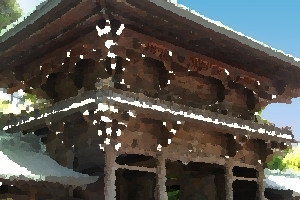A national treasure ensconced in a picturesque garden and hectares upon hectares of shady trees, the Meiji Jingu Shrine is Tokyo's largest. This shrine is also among the country's most sacred shrines and is one of three Imperial Shrines (or jingu). It is built in the middle of the Yoyogi Park, making it a tranquil oasis amidst the urban sprawl that is Tokyo.
The shrine was built in 1920 to honor the lives of Emperor Meiji and his wife, Empress Shoken. The Emperor Meiji is instrumental in bringing Japan to the forefront as an economic power. He also laid the groundwork for the opening of Japan to the rest of the world. For his accomplishments, the emperor was revered and loved by his people.
The Meiji Jingu is a testament to the beauty and grace of Japanese shrine architecture. Its simple yet elegant lines and muted colors offer a startling yet fascinating contrast to the Tokyo skyline's modern buildings. Sadly, the original structures were destroyed by the air raids during the Second World War, so what you will see will be reproductions that were made only in 1958. Nonetheless, it still captures the essence and magnificence of the original structures.
 A building of the Meiji Jingu sanctuary. [CC] credit.
A building of the Meiji Jingu sanctuary. [CC] credit.Made from water-resistant Japanese cypress, the Shrine remains unpainted, which only adds to its air of natural refinement. Green copper plates cover the roofs of the shrine and give it an attractive green, rusty look. Chuta Ito, the renowned modern Japanese architect, designed the shrine. The Shrine gate (Torii) stands at 12 meters and is 9.1 meters wide from post to post. It is also made of Japanese cypress and is the largest such gate in Japan.
The outer garden, called the Gaien, between the Shrine gate and the main shrine. This is where you can pore over an extensive collection of murals that depict the lives of Japan's beloved emperor and empress. The Gaien also houses the National Stadium and the Meiji Memorial Hall, a popular site for Shinto weddings. Come closer and visit the Naien, the inner garden, where more treasures await. This is where the main shrine and the Meiji Jingu Treasure Museum are located. The museum houses belongings and mementos of the emperor and empress, including their coronation carriage.
Between the two of them, the Naein and the Gaien have over a hundred thousand trees. The trees are made up of a variety of species and came from donations from all over Japan. It is said that all the species of trees in the country are represented here. The gardens themselves are delightful quiet spaces, spots of tranquility amidst the hustle and bustle of ultra-modern Tokyo. Drink in the sight of over a thousand irises in bloom (come June) and enjoy the simple pleasure of listening to birds twittering and insects humming in the trees.
 A Meiji Jingu sanctuary courtyard. [CC] credit.
A Meiji Jingu sanctuary courtyard. [CC] credit.When visiting, be sure to take note of how you will properly pay your respects by first purifying your hands and mouths with water from a stone basin. Also, please take note of the wooden plaques with wishes written on them. You may also buy charms and souvenirs at the shops to be found in the area.
The best times to visit the Meiji Shrine is during the springs when the flowers are in full bloom and come to New Year's Eve when millions flock to its gardens to usher in the new year. If you are lucky, you can also get to see a traditional Shinto wedding, which provides insights into Japanese culture.